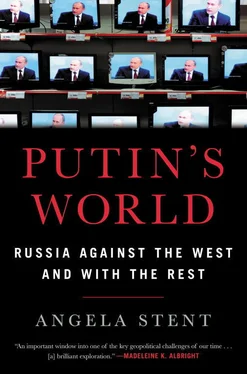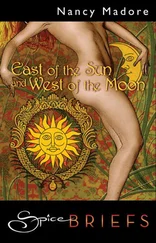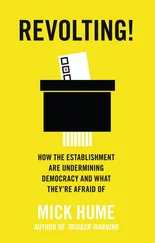The domestic impediments to a closer Trump-Putin relationship obscured an important reality: even without a “Russiagate,” what was the US-Russia agenda? What did both sides want from each other, and how did they define their respective interests? Whatever the president himself wanted, Trump had appointed a national security team—Rex Tillerson at State, James Mattis at Defense, and H. R. McMaster as national security adviser—who dealt with their Russian counterparts and cautiously sought ways to move the relationship forward. Congress meanwhile was pursuing its own confrontational policy toward Russia. There appeared to be three Russia policies in the Trump administration: that of the White House, that of the rest of the executive branch, and that of the Congress.
THE TRUMP ADMINISTRATION’S THREE RUSSIA POLICIES
Russia hoped that Trump’s election would usher in a new era of closer US-Russia relations and that Washington would finally give Moscow the respect it had not received since Putin returned to the Kremlin in 2012. Early on in the administration, Putin took the initiative and dispatched Deputy Foreign Minister Sergei Ryabkov to the State Department to propose a sweeping revamp of relations. The reset would involve discussions on cybersecurity, Afghanistan, the Iran nuclear deal, the situation in Ukraine, and the denuclearization of the Korean Peninsula. There would be regular consultations between the two presidents, their intelligence chiefs, and other cabinet officials from both sides. Many of the Obama-era military and diplomatic channels closed after the annexation of Crimea would be reopened. This amounted to a full-scale normalization of relations back to where they had been while Obama and Medvedev were still presidents. But the reset ignored everything that had caused the relationship to deteriorate since then, as if the election interference and the Ukraine crisis had never happened. 51The US State Department declined to confirm the report of the Russian proposal, but the Russian side did. “Yes, of course, such proposals in various formats were passed to the US,” Putin spokesman Dmitry Peskov told reporters. “Moscow consistently came out for the resumption of dialogue, for the exchange of opinions, for trying to find joint resolutions, but, unfortunately, was not met here with reciprocity.” 52
Apparently the Kremlin believed that President Trump and his advisers would be open to these proposals, and that knowledge of their election interference would have little impact on bilateral relations because Trump had won and would be free to move forward with Russia. It took the Russian leadership some time to understand the full ramifications of its tampering.
It soon became clear that there was a disconnect between President Trump’s forward-looking views of Russia and those of his cabinet colleagues and the US Congress, lending a significant degree of incoherence to the United States’ Russia policy. Secretary of State Rex Tillerson, like his colleagues at Defense and the National Security Council, was determined to engage Russia cautiously. The former CEO of ExxonMobil had considerable experience dealing with Russia, had been going to Russia since the 1990s, and had received the Order of Friendship from Putin in 2013. He had worked closely with Igor Sechin, CEO of Rosneft and arguably Russia’s second most powerful man. 53Rosneft and ExxonMobil had signed a multibillion-dollar agreement to jointly explore the Arctic, but that deal had been scuttled as a result of the post-Crimea sanctions on energy technology. After his first trip to Russia as secretary of state and meetings with Putin and Lavrov in April 2017, he acknowledged there was a “low level of trust.” He subsequently crafted a three-point plan for working with Russia: first, push back against Russian aggressive acts against the United States; second, engage Russia on issues that are of strategic interest to the United States; third, seek to establish “strategic stability” with Russia on a longer-term basis. This strategy was similar to that of the Obama administration after 2015. 54That is not surprising, given that the issues that dominated US-Russia relations after 2014 had not gone away.
The Trump administration reestablished some channels of communication that had previously been suspended, such as direct talks between the US and Russian chiefs of the general staff, talks between the intelligence chiefs, and talks between Tillerson and Lavrov. A strategic stability channel was established between the US undersecretary of state and the Russian deputy foreign minister. The new Russian ambassador to Washington, Anatoly Antonov, a veteran defense official, sought—with limited success—to reach out to different constituencies in Washington. His counterpart, Ambassador Jon Huntsman, former governor of Utah and former ambassador to China, did likewise in Moscow, seeking to promote business ties—a challenge in an era of cascading US congressional sanctions. Eschewing the idea of resets, Huntsman explained his policy: “Just take the relationship for what it is, clear-eyed and realistically,” adding that his work “is completely disassociated from the Mueller investigation because it’s work that you just need to get done in a relationship among major powers.” 55
As 2017 wore on, a series of sanctions, counter-sanctions, and diplomatic expulsions continued to fracture the relationship. The US Congress, which took an even tougher approach toward Russia than either the executive branch’s national security team or certainly the White House, was determined to impede any reset with Russia that would not hold Moscow to account for its election interference. In July, fearing that Trump might unilaterally lift the Obama-era sanctions on Russia, the Senate passed the Countering America’s Adversaries Through Sanctions Act (CAATSA) by a vote of 98–2. The act, among other provisions, imposes sanctions on some energy transactions with Russia. But its potentially most far-reaching impact is contained in a clause requiring the administration to submit to Congress lists of Russian oligarchs and political figures close to Putin who could be personally sanctioned. Trump, whose ability to lift sanctions was severely constrained by this legislation, reluctantly signed the bill, which, he said, contained “clearly unconstitutional provisions.” 56Indeed, Igor Sechin, who had been personally sanctioned in 2014, called the new legislation “sanctions against Trump.” When the administration eventually delivered the names of individuals to Congress, it consisted of the Forbes list of 96 Russian billionaires and what amounted to the telephone directory for 114 Russian government officials, giving the impression that it did not favor sanctioning anyone. On March 15, 2018, the first round of sanctions began. The Treasury Department sanctioned a group of individuals and organizations for “destabilizing activities, ranging from interference in the 2016 US election to conducting destructive cyber-attacks.” The sanctions included individuals listed in the Mueller indictment but extended to actors who “have also targeted US government entities and multiple US critical infrastructure sectors, including the energy, nuclear, commercial facilities, water, aviation, and critical manufacturing sectors.” 57
The Kremlin retaliated to the August sanctions by seizing two US diplomatic properties and ordering the United States to reduce its Moscow embassy staff by 755 people. Most of these people were Russian nationals who provided necessary support for the visa office and many other parts of the embassy. Trump responded by thanking Putin: “I’m very thankful that he let go of a large number of people, because now we have a smaller payroll.” 58Nevertheless, the cuts had an adverse effect on the ability of the embassy and consulates to function efficiently, including issuing visas to Russians in a timely fashion. Some Russians living in Moscow applying for US visas had to travel to the US consulate in Vladivostok—four thousand miles and seven time zones away, and even to other countries—to get their visas. Moreover, the US ambassador lost his chief interpreter and most of his political staff.
Читать дальше












